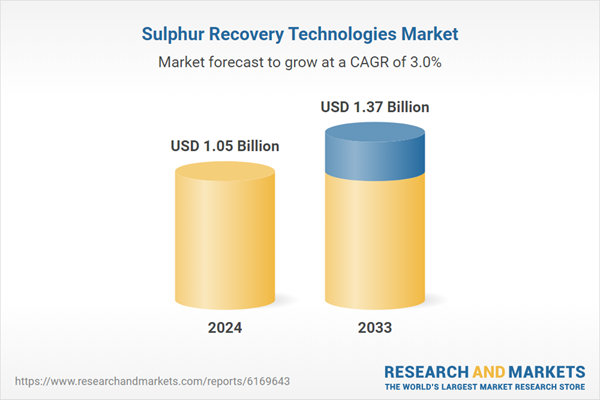Dublin, Nov. 04, 2025 (GLOBE NEWSWIRE) -- The "Sulphur Recovery Technologies Market Report by Technology, Source, Countries and Company Analysis, 2025-2033" has been added to ResearchAndMarkets.com's offering.
The Sulphur Recovery Technologies Market is expected to grow tremendously, from US$ 1.05 billion in 2024 to US$ 1.37 billion by 2033. This growth will be at a Compound Annual Growth Rate (CAGR) of 3.02% between the years 2025 and 2033. Increasing demand for efficient pollution control and eco-friendly solutions across industries are some of the driving factors behind this positive growth.

Sulphur Recovery Technologies Market Outlook
Sulphur Recovery Technologies (SRT) are the different technologies and processes used to recover elemental sulphur from hydrogen sulphide (H2S) present in natural gas and other industrial materials. SRT is important in the oil and gas sector as it aids in controlling emissions and reducing environmental effects. The most popular technology used is the Claus process, which uses chemical reactions to transform H2S into elemental sulphur.
Application of sulphur recovery technologies is becoming increasingly popular because environmental regulations that control sulphur emissions are put in place to decrease sulphur emissions, which are understood to cause air pollution and acid rain. Moreover, because industries want sustainable operations, sulphur recovery can also be economically advantageous by creating a valuable byproduct that may be sold or recycled for different uses, such as fertilizer manufacture and chemical production.
Growth Drivers in the Sulphur Recovery Technologies Market
Strict Environmental Regulations Fueling Adoption
World governments are enforcing strict emission norms to prevent sulfur dioxide (SO?) and other emissions from oil refineries, natural gas facilities, and petrochemical plants. In order to meet these regulations, industries must install or replace sulfur recovery units (SRUs) to ensure that sulfur compounds are safely reduced to elemental sulfur. Non-compliance will result in exorbitant fines, business closure, and reputational loss, making sulfur recovery technology an unavoidable investment.
Increased Oil & Gas Processing Activities
International energy consumption keeps growing, with emerging economies propelling more demand for natural gas and refined petroleum products. Most of these resources have high concentrations of hydrogen sulfide (H?S), which requires effective sulfur recovery during treatment. Increasing refining capacity in North America, the Middle East, and Asia-Pacific, as well as new sour-gas developments, translates into expanding demand for sulfur recovery units.
Technological Developments and Gains in Efficiency
Developments in sulfur recovery technologies have enhanced efficiency, reliability, and cost savings, hence the appeal to operators. Advances in Claus process design, new catalysts, and integrated tail-gas treatment units now make recovery efficiency greater than 99.5% possible. Digitalization and automation of processes make feed variability easier to control, ensuring optimal energy consumption and reduced emissions.
Challenges Faced by the Sulphur Recovery Technologies Market
Capital and Operating Expenses
Implementation of sulfur recovery technologies, especially Claus units with built-in tail-gas treatment equipment, involves huge capital investment. The intricacy of installation, requirement of skilled personnel, and integration into current refinery or gas plant facility all contribute to higher project cost.
Operational Challenges and Feed Variability
Hydrocarbon refining tends to mean dealing with very variable feedstocks with varying amounts of hydrogen sulfide and other impurities. This volatility impacts sulfur recovery unit performance, elevating risks of catalyst poisoning, fouling, or sulfur plugging. Maintenance of best operating conditions necessitates advanced monitoring systems and experienced operators.
Sulphur Recovery Claus Process Technologies Market
The Claus process is the dominant sulfur recovery technology globally. It is a combination of thermal and catalytic processes that oxidize hydrogen sulfide to elemental sulfur with recovery efficiencies ranging generally from greater than 95% and, when combined with tail-gas treatment, greater than 99%. Its simplicity, scalability, and proven track record have established it as the industry standard in oil refineries and gas processing facilities.
Key Attributes
| Report Attribute | Details |
| No. of Pages | 200 |
| Forecast Period | 2024-2033 |
| Estimated Market Value (USD) in 2024 | $1.05 Billion |
| Forecasted Market Value (USD) by 2033 | $1.37 Billion |
| Compound Annual Growth Rate | 3% |
| Regions Covered | Global |
Key Topics Covered
1. Introduction
2. Research & Methodology
3. Executive Summary
4. Market Dynamics
4.1 Growth Drivers
4.2 Challenges
5. Global Sulphur Recovery Technologies Market
5.1 Historical Market Trends
5.2 Market Forecast
6. Market Share Analysis
6.1 By Technology
6.2 By Source
6.3 By Countries
7. Technology
7.1 Claus Process
7.2 Tail Gas Treatment
8. Source
8.1 Oil
8.2 Gas
8.3 Others
9. Countries
9.1 North America
9.2 Europe
9.3 Asia Pacific
9.4 Latin America
9.5 Middle East & Africa
10. Value Chain Analysis
11. Porter's Five Forces Analysis
11.1 Bargaining Power of Buyers
11.2 Bargaining Power of Suppliers
11.3 Degree of Competition
11.4 Threat of New Entrants
11.5 Threat of Substitutes
12. SWOT Analysis
12.1 Strength
12.2 Weakness
12.3 Opportunity
12.4 Threats
13. Pricing Benchmark Analysis
14. Key Players Analysis
14.1 Bechtel Corporation (Bechtel Group Inc.)
14.2 Black & Veatch Holding Company
14.3 Chiyoda Corporation
14.4 KT-kinetics technology S.p.A.
14.5 Linde plc
14.6 Shell plc
14.7 Sulfur Recovery Engineering Inc.
14.8 WorleyParsons Ltd.
For more information about this report visit https://www.researchandmarkets.com/r/wpg38j
About ResearchAndMarkets.com
ResearchAndMarkets.com is the world's leading source for international market research reports and market data. We provide you with the latest data on international and regional markets, key industries, the top companies, new products and the latest trends.
Attachment
